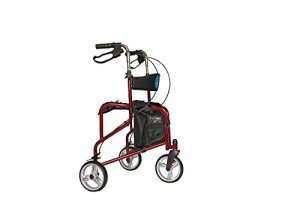
Adjustable Walker
Add a review FollowOverview
-
Sectors Health Care
-
Posted Jobs 0
-
Viewed 5
Company Description
20 Tips To Help You Be More Efficient At Lightweight Walker

The Lightweight Walker: A Comprehensive Guide
Introduction
Lightweight walkers are necessary mobility aids designed to assist individuals who have trouble walking or preserving balance. Unlike standard walkers, which can be cumbersome and heavy, lightweight walkers use enhanced portability and ease of use. This post checks out the features, benefits, and various kinds of lightweight walkers readily available, making it a valuable resource for people seeking enhanced mobility, caregivers, and health care specialists.
Understanding Lightweight Walkers
Lightweight walkers are generally built from products such as aluminum or carbon fiber. Their style prioritizes both durability and ease of transportation and use. The development in engineering and production strategies has caused the advancement of models that can be effortlessly steered, making them appropriate for a broad range of users.

Secret Features of Lightweight Walkers
- Material: Most lightweight walkers are made from high-strength aluminum or carbon fiber, making them easy to lift and transport.
- Foldability: Many designs include a folding style for practical storage and transportation.
- Weight Capacity: Despite their lightweight nature, they are built to sustain significant weight while maintaining stability.
- Adjustable Height: Most walkers offer Adjustable Walker height settings to accommodate users of differing heights.
- Brakes and Wheels: Some models consist of wheels for increased mobility, in addition to brakes for safety when resting.
Here’s a contrast table of some popular models of lightweight walkers to help users make informed decisions:
| Model | Weight | Weight Capacity | Functions | Price Range |
|---|---|---|---|---|
| Drive Medical 10210-1 | 5 pounds | 300 pounds | Foldable, non-slip hand grips, lightweight | ₤ 60 – ₤ 80 |
| Nova 4200 | 8 lbs | 250 pounds | 8″ wheels, a built-in seat, and adjustable | ₤ 120 – ₤ 150 |
| Medline E0302 | 7 lbs | 300 pounds | Side folding, 5″ wheels, and ergonomic grips | ₤ 70 – ₤ 100 |
| Hugo Folding Walker | 6 lbs | 300 pounds | Adjustable height, consists of backrest seat | ₤ 80 – ₤ 110 |
| Mego Mobility Indoor Walker | 8 lbs | 350 lbs | Double brakes, adjustable arms, addition of a basket | ₤ 90 – ₤ 130 |
Benefits of Lightweight Walkers
Lightweight walkers offer numerous advantages to users, enhancing both mobility and lifestyle. Some of the significant benefits consist of:
- Improved Mobility: They help individuals ambulate securely and with confidence, enabling them to engage in day-to-day activities and preserve independence.
- Relieve of Transport: The lightweight nature and collapsible design make them easy to carry in cars or public transport.
- Customization: Many walkers enable height changes, ensuring a comfortable fit tailored to the user.
- Improved Stability: These walkers supply the support needed to help avoid falls and injuries, particularly in older grownups.
- Range of Designs: With a range of styles offered, users can choose walkers that best fit their individual preferences and requirements.
Kinds Of Lightweight Walkers
-
Requirement Walkers: Basic designs designed mainly for stability with rubber suggestions, providing stability however minimal mobility.
-
Two-Wheeled Walkers: Equipped Days Breeze 4-Wheel Rollator with Basket – Durable Mobility (mymobilityscooters.uk) front wheels, these walkers offer enhanced maneuverability while still providing support.
-
Four-Wheeled Walkers (Rollators): These walkers feature wheels on all four legs, making them much easier to browse over different surfaces. Lots of likewise include a seat, providing rest during long trips.
-
Tri-Wheeled Walkers: Ideal for users who require more dexterity in tight areas, tri-wheel designs are compact yet sturdy.
Selecting the Right Lightweight Walker
When picking a lightweight walker, consider the following elements:
- User’s Weight and Height: Ensure the walker can accommodate the user’s size efficiently.
- Planned Use: Understand where the Modern Walker will be mostly utilized (inside your home vs. outdoors) and select wheels appropriately.
- Frequency of Use: For those utilizing the walker daily, comfort features, such as grips and seat choices, may be required.
- Safety Features: Look for designs with adequate brakes or locking systems to make sure stability.
Often Asked Questions
Q1: Are lightweight walkers more pricey than conventional walkers?A1: Generally, lightweight walkers can be slightly more pricey than conventional walkers due to their advanced products and features, but they offer considerable benefits in mobility and ease of use. Q2: Can I use a lightweight walker if I have substantial
mobility issues?A2: Yes, lightweight walkers are suitable for different mobility levels.
Nevertheless, it’s advised to speak with a health care supplier or physical therapist for tailored suggestions. Q3: Do lightweight walkers included warranties?A3: Most trusted producers offer warranties, typically
ranging from one to three years, but it’s essential to
inspect private item details. Q4: How do I keep my lightweight walker?A4: Regularly examine for wear on wheels, brakes, and grips. Clean the walker with a damp
fabric and prevent exposure to harsh chemicals. Q5: Are there options for personalizing lightweight walkers?A5: Yes, many makers offer adjustable functions such as color choices, accessory of bags, and seat cushions
. Lightweight walkers are invaluable mobility aids that improve self-reliance
, stability, and lifestyle for numerous individuals. Understanding the numerous features, benefits, and types
offered can help users make notified decisions. By choosing the right walker, people will find they can navigate their surroundings with confidence and ease. As the population continues to age, lightweight walkers will remain essential tools for mobility, making sure that everyone keeps their liberty to move securely and successfully.